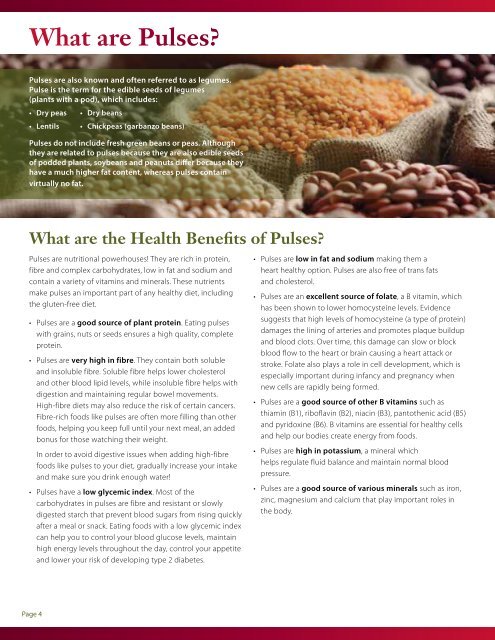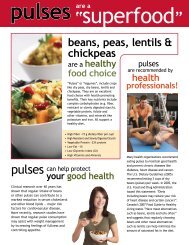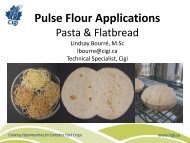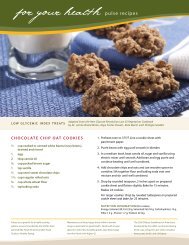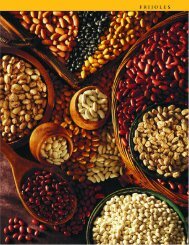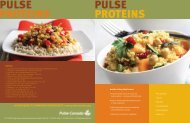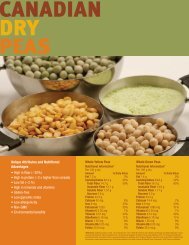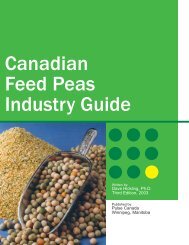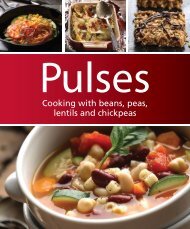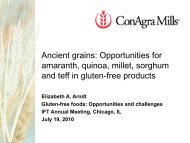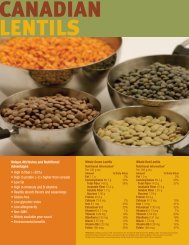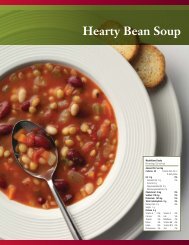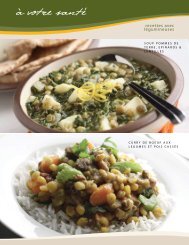Large Scale Recipe Manual - Pulse Canada
Large Scale Recipe Manual - Pulse Canada
Large Scale Recipe Manual - Pulse Canada
You also want an ePaper? Increase the reach of your titles
YUMPU automatically turns print PDFs into web optimized ePapers that Google loves.
What are <strong>Pulse</strong>s?<br />
<strong>Pulse</strong>s are also known and often referred to as legumes.<br />
<strong>Pulse</strong> is the term for the edible seeds of legumes<br />
(plants with a pod), which includes:<br />
• Dry peas<br />
• Lentils<br />
• Dry beans<br />
• Chickpeas (garbanzo beans)<br />
<strong>Pulse</strong>s do not include fresh green beans or peas. Although<br />
they are related to pulses because they are also edible seeds<br />
of podded plants, soybeans and peanuts differ because they<br />
have a much higher fat content, whereas pulses contain<br />
virtually no fat.<br />
What are the Health Benefits of <strong>Pulse</strong>s?<br />
<strong>Pulse</strong>s are nutritional powerhouses! They are rich in protein,<br />
fibre and complex carbohydrates, low in fat and sodium and<br />
contain a variety of vitamins and minerals. These nutrients<br />
make pulses an important part of any healthy diet, including<br />
the gluten-free diet.<br />
• <strong>Pulse</strong>s are a good source of plant protein. Eating pulses<br />
with grains, nuts or seeds ensures a high quality, complete<br />
protein.<br />
• <strong>Pulse</strong>s are very high in fibre. They contain both soluble<br />
and insoluble fibre. Soluble fibre helps lower cholesterol<br />
and other blood lipid levels, while insoluble fibre helps with<br />
digestion and maintaining regular bowel movements.<br />
High-fibre diets may also reduce the risk of certain cancers.<br />
Fibre-rich foods like pulses are often more filling than other<br />
foods, helping you keep full until your next meal, an added<br />
bonus for those watching their weight.<br />
In order to avoid digestive issues when adding high-fibre<br />
foods like pulses to your diet, gradually increase your intake<br />
and make sure you drink enough water!<br />
• <strong>Pulse</strong>s have a low glycemic index. Most of the<br />
carbohydrates in pulses are fibre and resistant or slowly<br />
digested starch that prevent blood sugars from rising quickly<br />
after a meal or snack. Eating foods with a low glycemic index<br />
can help you to control your blood glucose levels, maintain<br />
high energy levels throughout the day, control your appetite<br />
and lower your risk of developing type 2 diabetes.<br />
• <strong>Pulse</strong>s are low in fat and sodium making them a<br />
heart healthy option. <strong>Pulse</strong>s are also free of trans fats<br />
and cholesterol.<br />
• <strong>Pulse</strong>s are an excellent source of folate, a B vitamin, which<br />
has been shown to lower homocysteine levels. Evidence<br />
suggests that high levels of homocysteine (a type of protein)<br />
damages the lining of arteries and promotes plaque buildup<br />
and blood clots. Over time, this damage can slow or block<br />
blood flow to the heart or brain causing a heart attack or<br />
stroke. Folate also plays a role in cell development, which is<br />
especially important during infancy and pregnancy when<br />
new cells are rapidly being formed.<br />
• <strong>Pulse</strong>s are a good source of other B vitamins such as<br />
thiamin (B1), riboflavin (B2), niacin (B3), pantothenic acid (B5)<br />
and pyridoxine (B6). B vitamins are essential for healthy cells<br />
and help our bodies create energy from foods.<br />
• <strong>Pulse</strong>s are high in potassium, a mineral which<br />
helps regulate fluid balance and maintain normal blood<br />
pressure.<br />
• <strong>Pulse</strong>s are a good source of various minerals such as iron,<br />
zinc, magnesium and calcium that play important roles in<br />
the body.<br />
Page 4


